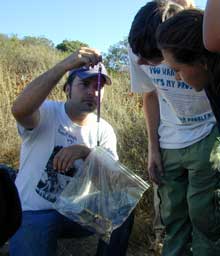Monitoring Objectives
In the spring of 2004 we commenced a long-term study that examines effects of coastal sage scrub restoration on small mammals. The goal of our sampling effort is to produce estimates of small mammal species composition, richness, diversity, abundance, and density over the course of habitat restoration, beginning at baseline (before thistle removal) through at least five years after restoration begins or until the small mammal communities resemble those found in our reference sites (pristine coastal sage scrub).
Methods
Trapping is conducted twice  per year (every 6 months) for three consecutive nights. As of January 2007 there are two trapping areas, each of which consists of a pair of sites. One site is an artichoke thistle-invaded stand undergoing restoration and the other is composed of pristine coastal sage scrub. These paired sites have been closely matched in respect to physical characteristics such as aspect, slope degree, and soil phase. Each restoration and pristine site contains a 3 x 11 trap grid containing 33 non-collapsible Sherman traps spaced 4m apart. Traps are baited with a mixture of rolled oats and peanut butter in the late afternoon and checked shortly after sunrise. Captured mammals are identified, weighed, and marked at the base of their tail prior to release. Trapping is conducted during periods of intermediate moonlight.
per year (every 6 months) for three consecutive nights. As of January 2007 there are two trapping areas, each of which consists of a pair of sites. One site is an artichoke thistle-invaded stand undergoing restoration and the other is composed of pristine coastal sage scrub. These paired sites have been closely matched in respect to physical characteristics such as aspect, slope degree, and soil phase. Each restoration and pristine site contains a 3 x 11 trap grid containing 33 non-collapsible Sherman traps spaced 4m apart. Traps are baited with a mixture of rolled oats and peanut butter in the late afternoon and checked shortly after sunrise. Captured mammals are identified, weighed, and marked at the base of their tail prior to release. Trapping is conducted during periods of intermediate moonlight.
